 |
Dinosaurs vs. Mammals- The battle during 150 million years -
|
Cat: SCI |
NHK Dinosaur Project supervised by Yoshitsugu Kobayashi |
08y30u/1822r |
Title
Dinosaurs
vs. Mammals
恐竜 vs. 哺乳類
Index
Tag
; 20-30 times bigger dinosaur; 3.5billion; 60% annihilated; Adelobasileus; Agile-warm-shrewed; Alive same age; Bestowal; Bigger egg; Bow legged; Breast-fed; Carbon density; Chicxulub; Coprolite; Digesting plants; Diurnal life; Feathered wing; Eutherian mammal; First mammal 10cm, 225ma; Frequent evolution; Full nourishment; Growing bigger in Jurassic; Gymnosperm - Angiosperm; Homeothermic; Insects diversified; Inversion of thumb; Lower Cretaceous - revolutional; Marsupial; Metatherian; New niche; Nocturnal mammal; Oxygen 10%; Pervis; Placenta - brain; Pollination; Present is the key; Pneumatic bone; Placenta; Repenomamus; Yolk hammocked;
Why?
-
There are several misunderstanding about geological
history, such as 1) Mammals evolved steadily in body size
and brain capacity, 2) Mammals are small but smart, while dinosaurs
are big but stupid, 3) Mammals have diversified after the extinction
of dinosaurs, 4) Human beings having intelligence appeared
in the last stage as necessary conclusion,etc.
-
This book describes a new story about mammals:
how mammals have endured and had unique and different surviving
strategy under the pressure of dinosaurs, happened to grasp a very
accidental chance since 65 mya (million years ago).
- 地史についてのいくつかの誤解がある。曰く、1) 哺乳類は身体のサイズも大脳の能力も確実に進化してきた。2) 哺乳類は小さくてスマートだが、恐竜は大きくて愚鈍である、3)
哺乳類は恐竜の絶滅後多様化してきた、3) 知能をもつ人類は必然的結末として最終段階で登場した、等々。
- この本は新しい哺乳類の物語である。哺乳類はいかに恐竜の圧力の下で耐え、独自の異なる生き残り戦略を行ってきたか、そして65百万年前の極めて偶然の機会をたまたま掴んだのかを記述している。
Key
phrase
キーフレーズ
>Top
0. Introduction:
- Geologic time:
- Proterozoic Era:
2500 - 543 mya
- Vendian: 650 -543 mya
- Advent of multicellular organism
- Paleozoic Era:
543 - 248 mya
- Cambrian: 543 - 490 mya
- Cambrian explosion
- Ordovicain: 490 - 443 mya
- Advent of marine vertebrate
- OS mass extinction
- Silurian: 443 - 417 mya
- Advent of terrestrial animals & jawed fish
- Devonian: 417 - 354 mya
- Advent of amphibian
- DC mass extinction
- Carboniferous: 354 -290 mya
- Advent of insect, gymnosperm, & reptile
- Permian: 290 - 248 mya
- PT mass extinction
- Mesozoic Era:
248 - 65 mya
- Triassic: 248 - 206 mya
- Advent of dinosaur & mammal
- TJ mass extinction
- Jurassic: 206 - 144 mya
- Advent of bird
- Cretaceous: 144 - 65 mya
- Advent of angiosperm
- CT mass extinction
- Cenozoic Era:
65 mya - today
- Tertiary: 65 - 1.8 mya
- Paleocene: 65 - 54.8 mya
- Advent of primate
- Eocene: 54.8 - 33.7 mya
- Oligocene: 33.7 to 23.8 mya
- Miocene: 23.8 - 5.3 mya
- Pliocene: 5.3 - 1.8 mya
- Quarternary: 1.8 - today
- Pleistocene: 1.8 mya - 10000 ya
- Advent of Homo Sapiens
- Holocene: 10000 ya - today
0.
序:
- 地質時代:
- 原生代: 2500 - 543百万年前
- ベンド紀: 650 -543
- 多細胞生物
- 古生代: 543 - 248
- カンブリア紀: 543 - 248
- カンブリア爆発
- オルドビス紀: 490 - 443
- 海洋脊椎動物の登場
- OS大量絶滅
- シルル紀: 443 - 417
- 陸上動物、顎のある魚類の登場
- デボン紀: 417 - 354
- 両生類の登場
- DC大領絶滅
- 石炭紀: 354 - 290
- 昆虫、裸子植物、爬虫類の登場
- 二畳紀: 290 -248
- PT大量絶滅
- 中生代: 248 -65
- 三畳紀: 248 -206
- 恐竜、哺乳類の登場
- TJ大量絶滅
- ジュラ紀: 206 -144
- 鳥の登場
- 白亜紀: 144 - 65
- 被子植物の登場
- CT大量絶滅
- 新生代: 65 - 現在
- 第三紀: 65 - 1.8
- 暁新世: 65 - 54.8
- 霊長類の登場
- 始新世: 54.8 - 33.7
- 漸新世: 33.7 - 23.8
- 中新世: 23.8 - 5.3
- 鮮新世: 5.3 - 1.8
- 第四紀: 1.8 - 現在
- 更新世: 1.8百万年前 - 10000年前
- 人類の登場
- 完新世: 10000年前 - 現在
>Top
1. Go mainstream:
- Adelobasileus, Fossil of the first mammal:
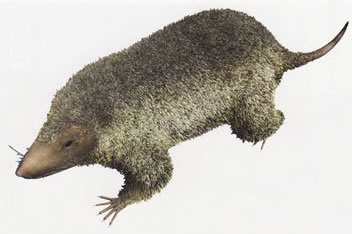
- In
Albuquerque in New Mexico: 10cm long, proto-mammals from the
late Triassic Era (225 mya)
- probably had eaten small insects.
- This fossil is found as a coprolite, probably eaten by some
reptile. --> fighting spirit award!
- Amphibian:
- Metposaurus, primitive frog, 1m long
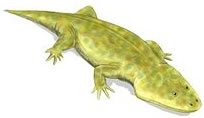
- Reptile:Desmatosuchus; 5m long

- Phytosaurs; 10m long.
- >Top Chinle Formation: later Triassic in US; 'Ghost Ranch' famous
site of Triassic dinosaur fossils. Fossils of dinosaurs and mammals
were found at the same formation; they were alive at almost same
age.
1.
表舞台への登場:
- アデロバシレウス:最初の哺乳類:
- アルバカーキ、NM州:、体長10cm、三畳紀末に登場した哺乳類の原型や
- 最初の化石は糞石として発見→【★敢闘賞】
- 両生類:
- メトポサウルス: 体長1m
- 爬虫類:
- デスマトスクス: 体長5m
- フィトサウルス: 体長10m
- チンリ層群 (米国):
- ゴースト・ランチ

-
 >Top Dinosaur:
>Top Dinosaur:
Coelophysis: dinosaur, 2-3m long, probably had eaten insects
and small lizards. This dinosaur is 20-30 times bigger than then
mammal.
- Desiccation and warming temperature:
- weakened limicoline animals such as Phytosaurs and
Metposaurus.
- drying world gave new niche world to mammals and dinosaurs.
- Supercontinent 'Pangea' existed 250 mya and were about to
sprit apart; increasing more CO2 emission.
- Elect bipedalism:
- Dinosaur completed the capacity of elect bipedlism; having
feet right below the body.
- succeeded to be able to aspirate and to run simultaneously.
- >Top Then the mammal (Aderobasileus):
- were still wriggling in
bow-legged.
- 恐竜:
- コエロフィシス: 体長2-3m
当時の哺乳類の20-30倍の大きさ
- 乾燥化と温暖化
- 水辺の動物の衰退
- 乾燥化は恐竜と哺乳類にとって有利
- 超大陸パンゲアの分裂次期。大量のCO2排出
- 直立二足歩行:
- 恐竜は直立二足歩行能力を獲得。胴体の真下に脚
- 呼吸と走行の同時実現
- 当時の哺乳類:
- がに股でくねくね歩き
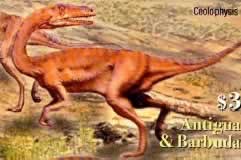
>Top 2. The first round of battle:
- Later Jurassic Era:
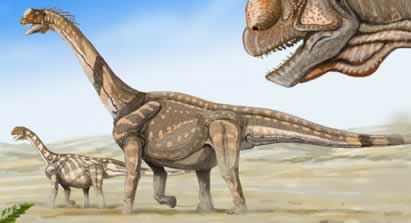
- Laolestes: nocturnal mammal with 15cm long, looks
like a mouse which didn't evolved much from Aderobasileus for
70M years.
- Gigantic dinosaur:
- Morrison
formation: of late Jurassic (150 mya) in western US;
called Morrison world.
- Cameras: 9-20m long, 20t weigh, herbivorous.
- Stegosaurus:8m long, herbivorous
- Allosaurus, 8.5 - 12m long, bipedal predator.
- Supersaurus, 33m long, 40t weigh, the largest hervivoros
dinosaur, ate 500kg of plants a day.

- >Top Pneumatic bone:
Respiratory system is important: air sac and pneumatic bone
enabled to adapt respiration in lower oxygen environment.
The bird has such air sac and pneumatic bone for flight.
- Fluctuation
of density of oxygen and carbon dioxide:
- R. Burner Curve:
Source: Atmospheric oxygen,
giant paleozoic insects and the evolution of aerial locomotor
performance; Robert Dudley, 1998
- This curve shows the density of carbon dioxide raised up
to 2000 ppm from Permian to Triassic era, which is almost five
time denser than now.
- >Top And that of oxygen decreased from 30% to 10% in the same
period.
- 11% density of oxygen is equivalent to the summit of 4,500m,
which was severe environment for most of plants and animals.
- In Triassic era, most of lives were annihilated; which caused
to prosper dinosaurs with air sac of pneumatic bone.
- >Top In Jurassic era, dinosaurs invested excess capacity of respiration
system into growing bigger in size, because the oxygen density
had recovered.
2.
戦いの第1ラウンド:
- ジュラ紀後期:
- ラオレステス: 体長15cm の夜行性の哺乳類
- 巨大恐竜:
- ジュラ紀後期のモリソン層群 (モリソンワールド)
- カマラサウルス:体長9-20m、体重20t
- ステゴサウルス:体長8m、植物食
- アロサウルス:体長8.5 -12m、二足肉食
- スーパーサウルス:体長33m、体重40t、最大の植物食恐竜。一日に500kgの植物を摂取
- 含気骨:
呼吸システムが重要:気嚢と含気骨によって低酸素環境下での呼吸に適用。鳥も飛行のためにこの気嚢と含気骨がある。
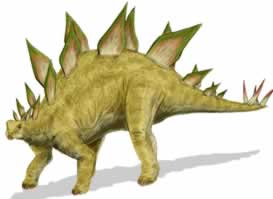
- 酸素と二酸化炭素濃度の変動:
- バーナー曲線
- この曲線によれば、二畳紀〜三畳紀にかけて二酸化炭素濃度は、現在の5倍にまで上昇 (2000 ppm)
- またこの期間、酸素濃度は30%から10%に減少。
- 11%の酸素濃度は4,500m の山頂と同じ。
- 三畳紀の環境は極めて過酷で、気嚢と含気骨をもつ交流が繁栄した理由。
- ジュラ紀では、酸素濃度の上昇によって、この呼吸システムの能力が巨大化に寄与した。
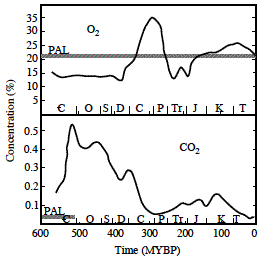
- >Top Higher density of carbon dioxide:
- higher density of carbon dioxide changed the plants.
- Evolution of food-chain shows that first carnivorous appears,
then omnivorous, and finally herbivorous animals appear. The
system of digesting of plants is complicated, which needs more
time to complete.
- Return to quadrupedlism from bipedlism was probably caused
by the shift from carnivorous to herbivorous,
- Gymnosperm plants have less nutritional value than angiosperm;
this caused dinosaurs to become bigger.
- Supersaurs:
- Supersaurs are believed to lay 30-40 eggs of melon size at
a time. The hatched eggs headed for forest to live bigger.
In 14-15 years they grew up showing maturity. (Lizards never
stop to grow, while dinosaurs grows rapidly during growth period
then stabilize their size like mammals.)
- >Top Homeothermic animals:
- Reptiles are poikilothermal, which can bear up against lasting
abrosia.
- Dinosaur seems in the process of shifting from poikilothermal
to homeothermal.
- Both dinosaurs and human species seem off-specification
of all time in terms of evolution types.
- 二酸化炭素濃度の上昇:
- 二酸化炭素濃度上昇によって植物相が変化
- 食物連鎖の進化では、まず肉食、つぎに雑食、最後に草食が登場。植物の消化システムは複雑で完成まで時間がかかる。
- 二足歩行から四足歩行への回帰はおそらく肉食から草食への変化の結果。
- 裸子植物は被子植物に比べて栄養価が低いので、大型化の原因。
- スーパーサウルス:
- 一度に30-40の卵を産卵。孵化した後、森を目指した。14-15年で成人。爬虫類は成長し続けるが、恐竜は哺乳類と同じく、成長期に急成長する。
- 恒温性動物:
- 両生類は変温性ゆえ、絶食に耐えられる。
- 恐竜は変温性から恒温性への変化の途中。
- 恐竜も人類も進化型としては共に規格外。
>Top 3. The second round of battle:
- Sinosauropteryx: 1.1m long feathered dinosaur, discovered
in 1996 at Lower Cretaceous, in Liaoningshen, China. The fossil
clearly shows trace of proto-feather, which probably covered
almost all body.
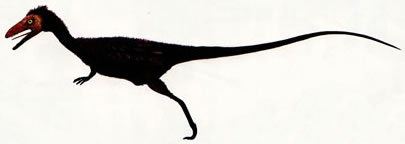
- Archaeopteryx was found in 1861 in Germany.
- These fossils indicate that (1) bird is
descendant of dinosaur, and (2)
dinosaur is homeothermal.
- >Top Descendant animals presume life style of the ancestor.
"Present is the key to the past."
- Meaning of having feather:
- The image of life style: from slow, cold-blooded, monotonous
to agile, warm-blooded, shrewd
- intersexual selection = male choice (Cf: intrasexual
selection = direct competition between usually males.)
- gliding ability, then flying ability
- inversion of thumb to grasp a branch.
- most of fossils were made in oxygen lacking condition
covered by phosphate rock.
- >Top Repenomamus: 0.5-1m
long mammal of Lower Cretaceous. This is famous to be found eating
child of dinosaur, psittacosaurus.
- 1m size is too big to be nocturnal, which advanced to diurnal
life.
- This is the first mammal which has overturned the fear life
by dinosaurs. -> Outstanding award! >Fig.
4.
戦いの第2ラウンド:
- シノサウロプテリクス(中華竜鳥):白亜紀前期遼寧省の地層から発見。化石には原始的な羽毛の一部が確認された。おそらく全身を覆っていたと思われる。
- 1861年にドイツで発見された始祖鳥以来の発見。
- この発見よって、1) 鳥が恐竜の子孫であること、2) 恐竜が恒温性であることを示唆する。
- 子孫の動物は先祖の生活スタイルを想定させる。「現在は過去を説く鍵」
- 羽毛を持つ意味:
- 生活スタイルのイメージが、のんびり、冷血、誕生から、活発、高温、機敏のイメージに
- 性淘汰 (異性間、同性間)
- まず滑空能力、それから飛翔へ
- 親指の反転で枝を掴めるように
- 多くの化石は酸欠状態で、燐灰岩に覆われていた。
- レペノマムス:体長0.5 - 1m。前期白亜紀。子供の恐竜を食べた哺乳類として有名。(Fig.)
- 1mのサイズは夜行性としては大きすぎるので、昼行性に移行
- 恐竜による恐怖の生活を打破した最初の哺乳類→【★殊勲賞】
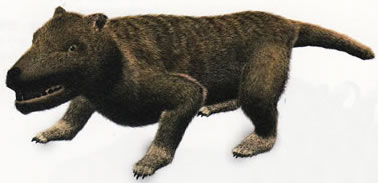
>Top 4. The strongest
dinosaur vs. new strategy of mammals:
- Sinodelphys; 15cm long, the oldest marsupial fossil, found
in 125 mya in Liaoning Province, China.
- Marsupial lays baby without eggshell.
- >Top breast-fed baby has baby teeth to protect its mother.
- viviparous is revolutionary method compared to oviparous.
Parents can warm by their body temperature and carry it
to safer places if needed.
- >Top Lower Cretaceous is a revolutionary period:
- Dinosaurs acquired feather.
- Birds became diversified.
- Angiosperm appeared.
- Archaefructus, 125 mya, is proposed to be the
earliest flowing plants.
- Pollination of anglosperm is more effective entromophilous
and omithophilous than gymnosperm's amemophilous.
4. 最強の恐竜vs.哺乳類の新戦略:
- シノデルフィス;体長15cm、最古の有袋類、中国遼寧省1.25億年前の地層から
- 卵の殻のない胎児を生む
- 母乳で育てる動物には乳歯がある。
- 胎生は卵生に比べ画期的な方法
- 体温で温め、安全な場所へ運搬できる。
- 初期白亜期は革命的な時期
- 恐竜は羽毛を持つ
- 鳥は多様化
- 被子植物が登場
- アルカエフルクトゥス;最古の花をつけた被子植物
- 裸子植物の受粉は風媒だが、被子植物は虫媒・鳥媒なので効率的
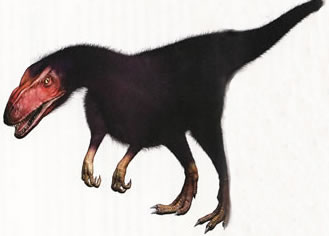 >Top Birds' child-raising policy:
>Top Birds' child-raising policy:
- lay bigger eggs compared to dinosaurs.
- Aepyornis (3m long) of Madagascar lay an 33cm egg.
- Cf:
Supersaurus (30m long) lay 30cm egg.
- Kiwi can lay eggs (once one egg per season) of six times
the size of chicken's egg.
- >Top Reptiles's egg is round, but birds' one is deformed Rugby
ball. (bigger Rugby ball egg can pass pelvis. )
- Chalaza of egg is like a hammock to support yolk in the
center of an egg.
- >Top Oviraptor; upper Cretaceous, most bird-like dinosaur, used
feathered wings to cover the eggs. This has been considered a
predator of eggs, but now is proposed to rename 'Ovinutrix' (egg
nurse).
- Dilong: under Cretaceous, 1.6m long, feather-having dinosaur, maybe
ancestor of Tyrannosaurus.
- maybe ancestor of Tyrannosaurus.
- Tyrannosaurus: its image changed;upper Cretaceous,13m long, the strongest dinosaur. This is a child of Tyrannosaurus,
fast runner with feather. Parent and their children jointly hunting.
- 鳥類の育児戦略:
- 恐竜に比べてより大きな卵を生む
- エピオルニス (体長3m) は33cmの卵を生む。
- Cf: 体長30mのスーパーサウルスでさえ、30cmの卵)
- キウィは鶏の6倍の卵を生む
- 爬虫類の卵は球形、鳥はラグビーボール状
- 卵のカラザは黄身をハンモック状に支える
- オビラプトール:後期白亜紀、羽毛を持ち卵を温める鳥のような恐竜。当初は卵泥棒という名がついたが、その後卵を温めていたことが判明
- ディロング:前期白亜紀、体長1.6m、羽毛恐竜、おそらくティラノサウルスの先祖
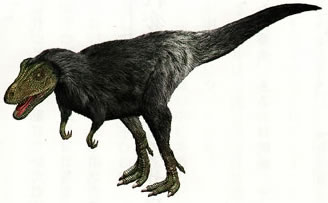
- ティラノサウルス:このイメージがチェンジ。後期白亜紀。体長13m、最強の恐竜。左図は子供のティラノサウルスで、羽毛と迅速な足を持つ。
>Top 5. The final round of battle - "The goal":
- How the present ecosystem was established:
- World of mammals, birds and angiosperm:
- Eutherian mammals appeared together with angiosperm
in lower Cretaceous.
- insects became diversified. (pollen carriers like butterflies
and bees)
- Mammals ate mostly insects as high energy food.
- Fruits and seeds appeared.
- Opposing thumb to grasp fruits.
- Humans cannot produce vitamin-C in the body.
- Canopy structure of forest of angiosperm
- >Top Evolution of life:
- it is history of producing new niche.
- Ephemera strategy:
- angiosperm, insects and mammals are relatively short-lived;
enabling frequent evolution.
- Eomaia: 125ma in Lower Cretaceous; 10 cm long, 20-25g weight; well preserved specimen.; earlier form of placental mammals though it lacks some features; having 5 upper and 4 lower icisors typical for metatherian.

- >Top Mammals evolved spending 150 my, and finally acquired placenta giving full nourishment to their children.
- ultimate reproduction strategy to secure descendants.
5.
最終ラウンド「ゴール」:
- 現在の生態系はいかに生まれたか:
- 哺乳類、鳥類、被子植物の世界
- 真獣類 (胎盤をもつ)と被子植物は前期白亜紀に同時に発展
- 昆虫も多様化 (花粉を運搬する蝶や蜂)
- 哺乳類は高エネルギーの昆虫が主食
- 果実と種子の登場
- 対向する親指:果実を掴むために
- 人間はビタミンCを体内で作れない
- 被子植物の森の林冠構造
- 生命の進化:
- 新たなニッチを作り出す歴史
- 短命戦略:
- 被子植物、昆虫、哺乳類は相対的に短命。頻繁な進化を可能にする
- エオマイア: 後期白亜紀 125ma, 体調10cm, 体重20-25g, 初期の胎盤を持つ真獣類; 【★技能賞】
- 哺乳類は150百万年かけて、最終的には胎盤を獲得。究極まで子供に栄養を与える。
- >Top Development of brain:
- unless dinosaurs; Could two of placenta and
brain developed?
- unless the mass extinction of 65 mya; Could dinosaurs
become intelligent?
- >Top Evolution to acquire intelligence: is it an inevitable consequence?
- Ecosystem of earth continued without intelligence for 3.5
billion years.
- Dinosaurs never showed to increase capacity of their brain.
- >Top The last night:
- A meteorite of 10km dropped in Yucatan Channel 65 mya. (Chicxulub crater)
- Why mammals could survive after fall of the meteorite?
- 60% of kinds of species annihilated; 70-80% of living
animals died.
- smaller size and shorter live are preferable for survival.
- Beautiful meteors showers over the heads of sleeping dinosaurs
and activating mammals.
- Could the prosperity of mammals not occurred without
annihilation of dinosaurs? ,,,YES
- Mammals have evolved internally of the body without
growing size behind the back of pressure of dinosaurs
since Mesozoic era.
- 大脳の発達:
- もし恐竜がいなければ胎盤と大脳は発達したか?
- もし65百万年前の大量絶滅がなければ:
恐竜は知性を獲得したか?
- 知性の獲得への進化:必然的な結果なのか?
- 地球の生態系は知性なしで35億年も続いてきた。
- 恐竜は大脳を大型化する動きを見せなかった。
- 最後の夜:
- 直径10kmの隕石がユカタン半島沖に落下 (チクシュルーブ・クレーター)
- なぜ哺乳類は隕石落下の後、生き延びられたのか?
- 60%の種が絶滅し、生きていた動物の70-80%が死滅
- 小型と短命は生き残りに有利
- 美しい流星が、眠りにつく恐竜と活動している哺乳類の頭上に降り注ぐ
- 恐竜の絶命なしには哺乳類の繁栄はなかったのか?答えはYes
- 哺乳類は、中生代以降、恐竜の圧力の陰で、巨大化せずに身体の内部を進化させてきた。
Comment
- Though a long story of life, after the continued battle of mammals
with dinosaurs, we are standing on this earth as descendant of
survived mammals.
- As our direct ancestors, I'd honor Adelobasileus found
as a coprolite in late Triassic, Eomaia who
acquired placenta and Repenomamus in Cretaceous
who ate a baby dinosaur.
- >Top Life is a bestowal from far past ancestors. Thus we have no liberty
to treat lives so easily.
- 長い生命の歴史を通じて、哺乳類による長い恐竜との闘いの後、我々はこの地球上に生き延びた哺乳類の子孫として立っている。
- 我々の直接の祖先として、糞石として発見された三畳紀末のアデロバシレウス、胎盤を獲得した白亜紀のエオマイア、そして子供の恐竜を食べたレペノマムスを表彰したい。
- 命は遠い祖先からの贈り物である。従って命を粗末に扱う自由は我々にはない。
Title |
Dinosaurs vs. Mammals |
恐竜 vs. 哺乳類 |
|---|---|---|
Index |
||
Tag |
; 20-30 times bigger dinosaur; 3.5billion; 60% annihilated; Adelobasileus; Agile-warm-shrewed; Alive same age; Bestowal; Bigger egg; Bow legged; Breast-fed; Carbon density; Chicxulub; Coprolite; Digesting plants; Diurnal life; Feathered wing; Eutherian mammal; First mammal 10cm, 225ma; Frequent evolution; Full nourishment; Growing bigger in Jurassic; Gymnosperm - Angiosperm; Homeothermic; Insects diversified; Inversion of thumb; Lower Cretaceous - revolutional; Marsupial; Metatherian; New niche; Nocturnal mammal; Oxygen 10%; Pervis; Placenta - brain; Pollination; Present is the key; Pneumatic bone; Placenta; Repenomamus; Yolk hammocked; |
|
Why? |
|
|
Key phrase |
キーフレーズ |
>Top 0. Introduction:
|
0. 序:
|
>Top 1. Go mainstream:
|
1. 表舞台への登場:
|
|
|
>Top 2. The first round of battle:
|
2. 戦いの第1ラウンド:
|
|
|
>Top 3. The second round of battle:
|
4. 戦いの第2ラウンド:
|
>Top 4. The strongest dinosaur vs. new strategy of mammals:
|
4. 最強の恐竜vs.哺乳類の新戦略:
|
|
|
>Top 5. The final round of battle - "The goal":
|
5. 最終ラウンド「ゴール」:
|
|
|
Comment |
|
|